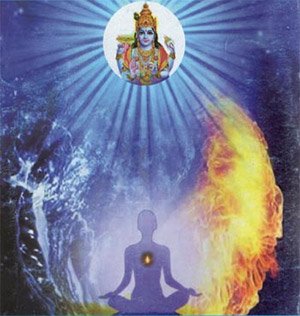Siddhanta Sangraha of Sri Sailacharya
by E. Sowmya Narayanan | 2008 | 30,562 words
Siddhanta Sangraha Chapter 21 (English translation), entitled “the transcendental form” as included in the critical edition and study. The Siddhanta Samgraha is a Sanskrit philosophical text dealing with Vishishtadvaita in five hundred Sanskrit verses. It was written by Shri Shailacarya (18th century) and closely follows the philosophy of Vedanta Deshika (13th century).
Chapter 21 - The Transcendental Form
188. In some contexts, Viṣṇu is stated to have originated along with Brahma and Śiva to complete the Trinity. This origination of Viṣṇu in the Trinity is different from the Transcendental form (pararūpa) of vāsudeva. The origination as Viṣṇu is for the purpose of cosmic function (vyūha rūpa).
189. The Supreme Lord along with His consort Śrī resolved to become manifold to attain various name and form and for that purpose He commenced the two fold creations namely, samaṣṭi and vyaṣṭi. According to the śruti the divine couple first creates the insentient entities which are called as samaṣṭi sṛṣṭi.
Conclusion:
 This concludes The Transcendental Form according to Vishishtadvaita philosophy explained by Shri Shailacarya. This book follows the model of Vedanta Deshika although the Vishishta Advaita school was originally expounded by Shri Ramanuja. Vishishta-Advaita is one of the various sub-schools of Vedanta which itself represents one of the six orthodox schools of Hindu Philosophy. They highlight the importance of the Upanishads, the Bhagavad Gita and the Brahma Sutras.
This concludes The Transcendental Form according to Vishishtadvaita philosophy explained by Shri Shailacarya. This book follows the model of Vedanta Deshika although the Vishishta Advaita school was originally expounded by Shri Ramanuja. Vishishta-Advaita is one of the various sub-schools of Vedanta which itself represents one of the six orthodox schools of Hindu Philosophy. They highlight the importance of the Upanishads, the Bhagavad Gita and the Brahma Sutras.
